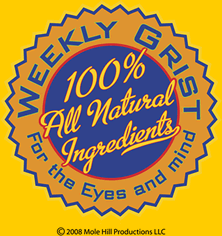|
|
|
|

|
|
|
|


Sunday, October 12, 2008 Eight rows of ripe soybeans are being quickly and efficiently severed from their stalks and sucked into this combine. Seconds later, in the belly of the beast, the beans are separated from husks, leaves, and stalks. The beans go to a bin in the belly. The stalks, husks, and leaves, neatly chopped into small pieces, are jettisoned from the rear of the combine and spread back onto the field, courtesy of a spinning fan with flexible blades. Both of the actions are desirable. The beans are clean and the remains of the plant are returned to the soil to fertilize the next generation. This combine traces its roots to Cyrus McCormick’s “reaper,” first put in use in 1831. The principles for that machine are alive and well today in the modern machine you see above. Prior to its invention, you swung a scythe to harvest grain. McCormick was a mere twenty-two years old when he hatched up his groundbreaking idea. The combine is a very efficient device from the standpoint of processing beans. However, it is a self-propelled machine which combines spinning, shaking, and vibration to accomplish its mission. Essentially, it begins to self-destruct the moment it goes into operation. John Cover, the owner of the machine, sauntered up while I was taking my photos. That’s John’s nephew perched in the cab and maneuvering the beast. We introduced ourselves and I explained that I was gathering material for a weekly Internet picture-story. Satisfied that mine was a benign pursuit, John quickly joined a nice conversation. I observed that a combine was an expensive machine that started to shake itself apart the minute it went into operation. “That’s most accurate description of a combine I’ve ever heard,” he said with an understanding grin. John briefly explained his farming operation. Bottom line: There were four combines operating in the field that day. All were operated by family members and relatives. John and his family represent a group which should earn our admiration. This group stands staunchly against the trend that sees foreign manufacturers more efficiently producing almost every product we see, feel and touch. This group is the American farmer. It is globally supreme in producing beans, corn, cotton, rice, and other essential crops. That supremacy doesn’t come easy. My visit with John took place after three o’clock on a Saturday afternoon. While others were watching the Razorbacks shellac Auburn’s Tigers on the TV, or playing golf, or fishing, or raising their couch-potato crop to a fine harvest, John Cover and his family were hard at it doing what had to be done. It all started with planting, probably in mid-to-late June. There are some knowns in farming. A soybean seed is genetically disposed to germinate, grow, and reach maturity with reasonable predictability. It’s what happens in between that makes the difference. The unknowns in the between time are legion. Bugs, worms, moths, weeds, too much rain, not enough rain, heavy-duty wind, hail storms — each and all contribute to gray hair and sleep deprivation for John, his family, and his neighbors. This year, John stayed ahead of the unknowns. His rich harvest of beans will show up, much to our benefit, in everything from printers ink to substitute dairy products. Thanks, John.
N O T E S:
Most of the time, there is more to the Photo of the Week story than can be told in an essay. And most of the time there are more pictures to be seen. Presuming that some folk will enjoy being privy to this trove of information, I have created a blog, “Weekly Grist for the Eyes and Mind,” where I am showing and telling “the rest of the story." There are also some blatantly commercial mentions of some of the things we do to earn our beans and taters. Click on the Weekly Grist logo and go to the blog. — J. D.

|
|
|
|
|
|

|
|
|
|
CornDancer.com is the personal website of Dr. Freddie A. Bowles and Ebenezer Baldwin Bowles.
CornDancer has participated in the World Wide Web since 2000. Submissions are invited. Contact webmaster at threadspinner@corndancer.com |
|
|
|


